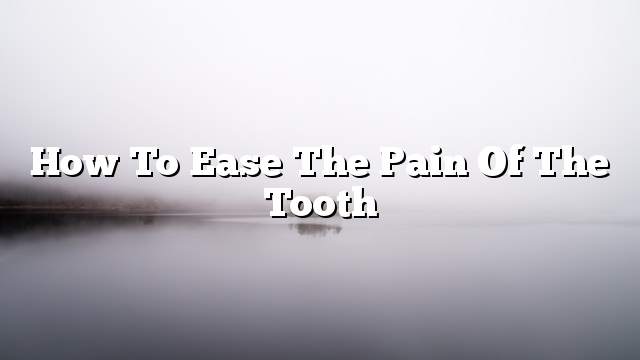Toothache
The pain of the teeth affects the teeth themselves, or the surrounding areas, and may affect the jaws, and the nature of the pain of the teeth, may be continuous and sometimes intermittent sometimes other, and the pain may be severe or moderate, may appear suddenly, it should be noted that the person may feel the pain of teeth as a result To eat and drink especially if the food or drink is cold or hot. The pain of the teeth increases when sleeping sometimes, and sometimes difficult to identify the source of pain, may feel pain in the ear in the case of pain in the lower teeth, and may feel pain in the pockets if there is pain in the upper teeth. Symptoms of pain that require a doctor to see the pain when chewing, or bleeding or leaking from the area surrounding the tooth, or feeling allergic to the teeth when eating cold or hot drinks, as well as when the exposure to injury or blow, or swelling of the gums Or jaw around the sprocket.
How to relieve dental pain
One of the basic steps to relieve tooth pain is the use of over-the-counter painkillers such as acetaminophen and ibuprofen. There are some home remedies that work to relieve tooth pain. It is worth noting that these recipes are given to pregnant and nursing women only after consultation with the doctor, and also to alert the person to the possibility of the interaction of these recipes with medicines for other diseases, consult with the doctor in such cases , And these recipes include:
- Using saline solution: The saline solution helps to reduce inflammation, accelerate the healing of wounds, and helps remove the lingering food residue between the teeth. Salt solution is also a natural sterilizer.
- Use of clove oil: Clove oil is placed on a small piece of cotton and is bitten to relieve pain. A few drops of clove oil can be added to a cup of water and used as a mouthwash. Clove oil has been used since ancient times to treat tooth pain because it has an effect on pain anesthesia and relaxation. This is due to the fact that it contains Eugenol, a natural sterilized substance.
- Use garlic: And then by adding it a little salt and then placed on the affected area, and works to reduce the pain of pain and reduce the chances of infection because it contains alicine (English: Allicin), which acts as a natural antibiotic, Bacteria that cause inflammation.
- Using Cold Compresses: Cold compresses help reduce pain by reducing the blood vessels in the affected area and also helping to relieve swelling and inflammation.
- Using mint tea bags: Put in water and then leave to cool, then placed on the affected area, or put the tea bag for two minutes in the freezer and then placed on the affected area.
- Using Thyme or Vanilla Extract: A little thyme or vanilla extract is placed on a small piece of cotton and placed on the pain area.
Causes of tooth pain
Dental Pulp contains nerve endings that are very sensitive to pain and also contain blood vessels. The pain is caused by inflammation of the tooth nerve caused by contact with the teeth. The tooth pain may be caused but without damage to the dental nerve. Common causes of dental pain are:
- Dental caries is one of the most common causes of tooth inflammation. Eating sugary foods feeds the bacteria in the mouth, which increases the secretion of acidic substances, which in turn dissolves the outer layers of the tooth and makes holes that allow bacteria and toxins. To enter and approach more than the core of the teeth, leading to irritation.
- Teeth Sensitivity: Sensitivity of teeth causes pain when teeth are exposed to different temperatures when eating cold or hot foods or drinks, or when the teeth are exposed to cold or hot air. Sensitivity also occurs in the case of preparing the tooth when making the dental crown in the dental clinic , Or when the crown is installed on the tooth.
- Dental abscess: The tooth abscess results from the bacterial infection of the tooth, which leads to the accumulation of abscess around the peak of the dental root.
- The presence of a broken tooth: These fractures are usually very small and can not be seen with the naked eye.
- Soft or broken tooth fillings: or broken tooth crowns.
- Dental fillings very close to the pulp of teeth.
- Teeth Grinding.
- Dental movement and instability: This occurs when orthodontic treatment is performed.
- The molars of the brain, or the molars that are in the process of emergence, causing the incision of the gums caused inflammation of the gums.
- Gum Recession: The gums recede; the gums shrink, leading to tooth roots, which are the most sensitive and soft areas of the rest of the tooth.
- Periodontal Abscess: Bacterial infection causes the pus to accumulate in the gums.
- There are ulcers in the gums, such as the cold sore or the mouth ulcer (Canker Sore).
- Sinusitis, which causes the patient to feel pain in the upper jaw.
- Temporomandibular joint damage.
- Children’s tooth eruption in a process called teething.
Prevention of dental pain
To prevent dental pain, care must be taken to maintain the cleanliness of the mouth and teeth, by regularly brushing teeth at least twice a day, using fluoride toothpaste, and advised to clean the gums and tongue also using the brush, to be done gently, and It is necessary to clean between the teeth using medical dental floss, use oral lye if necessary, as well as to clean the teeth in the dental care clinic twice a year, reduce sugars and carbohydrates in food, and refrain from smoking.
